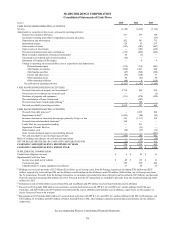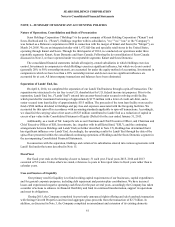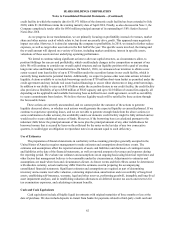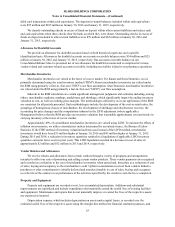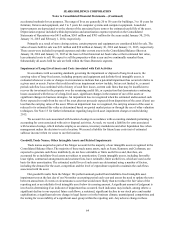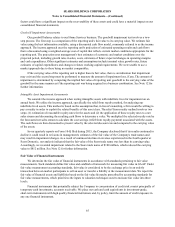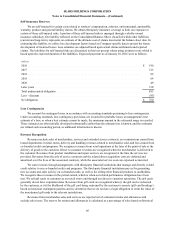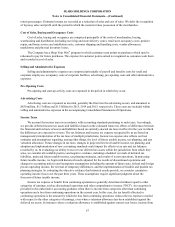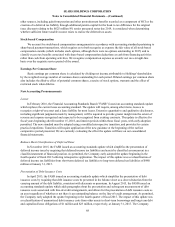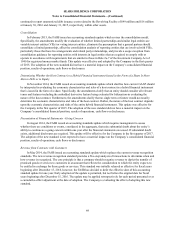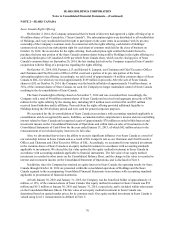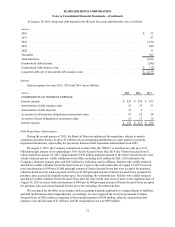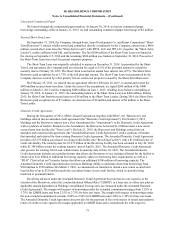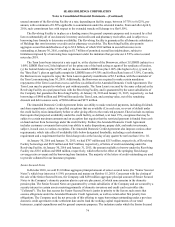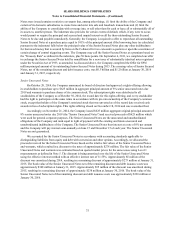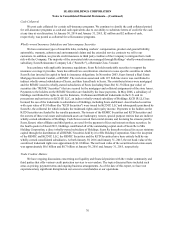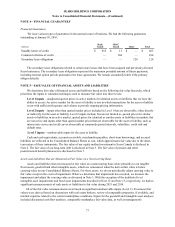Sears 2015 Annual Report Download - page 68
Download and view the complete annual report
Please find page 68 of the 2015 Sears annual report below. You can navigate through the pages in the report by either clicking on the pages listed below, or by using the keyword search tool below to find specific information within the annual report.
other sources, including gain from pension and other postretirement benefits recorded as a component of OCI or the
creation of a deferred tax liability through additional paid-in capital for the book to tax difference for the original
issue discount relating to the $625 million 8% senior unsecured notes due 2019, is considered when determining
whether sufficient future taxable income exists to realize the deferred tax assets.
Stock-based Compensation
We account for stock-based compensation arrangements in accordance with accounting standards pertaining to
share-based payment transactions, which requires us to both recognize as expense the fair value of all stock-based
compensation awards (which includes stock options, although there were no options outstanding in 2015) and to
classify excess tax benefits associated with share-based compensation deductions as cash from financing activities
rather than cash from operating activities. We recognize compensation expense as awards vest on a straight-line
basis over the requisite service period of the award.
Earnings Per Common Share
Basic earnings per common share is calculated by dividing net income attributable to Holdings' shareholders
by the weighted average number of common shares outstanding for each period. Diluted earnings per common share
also includes the dilutive effect of potential common shares, exercise of stock options, warrants and the effect of
restricted stock when dilutive.
New Accounting Pronouncements
Leases
In February 2016, the Financial Accounting Standards Board ("FASB") issued an accounting standards update
which replaces the current lease accounting standard. The update will require, among other items, lessees to
recognize a right-of-use asset and a lease liability for most leases. Extensive quantitative and qualitative disclosures,
including significant judgments made by management, will be required to provide greater insight into the extent of
revenue and expense recognized and expected to be recognized from existing contracts. The update€is effective for
fiscal years beginning after December 15, 2018, and interim periods within those fiscal years, with early adoption
permitted. The new standard must be adopted using a modified retrospective transition, and provides for certain
practical expedients. Transition will require application of the new guidance at the beginning of the earliest
comparative period presented. We are currently evaluating the effect the update will have on our consolidated
financial statements.
Balance Sheet Classification of Deferred Taxes
In November 2015, the FASB issued an accounting standards update which simplifies the presentation of
deferred income taxes by requiring that deferred income tax liabilities and assets be classified as noncurrent in a
classified statement of financial position. As permitted, the Company early adopted the update beginning in the
fourth quarter of fiscal 2015 utilizing retrospective application. The impact of this update was a reclassification of
deferred income tax liabilities from short-term deferred tax liabilities to long-term deferred tax liabilities of $480
million at January€31, 2015.
Presentation of Debt Issuance Costs
In April 2015, the FASB issued an accounting standards update which simplifies the presentation of debt
issuance costs by requiring that debt issuance costs be presented in the balance sheet as a direct deduction from the
carrying amount of the debt liability, consistent with discounts or premiums. In August 2015, the FASB issued an
accounting standards update which adds paragraphs about the presentation and subsequent measurement of debt
issuance costs associated with line-of-credit arrangements, and allows for the presentation of debt issuance costs as
an asset regardless of whether or not there is an outstanding balance on the line-of-credit arrangement. As permitted,
the Company early adopted the update beginning in the fourth quarter of fiscal 2015. The impact of this update was
a reclassification of unamortized debt issuance costs from other assets to short-term borrowings and long-term debt
and capitalized lease obligations of $1 million and $23 million, respectively, at January€31, 2015. The Company
SEARS HOLDINGS CORPORATION
Notes to Consolidated Financial Statements—(Continued)
68



